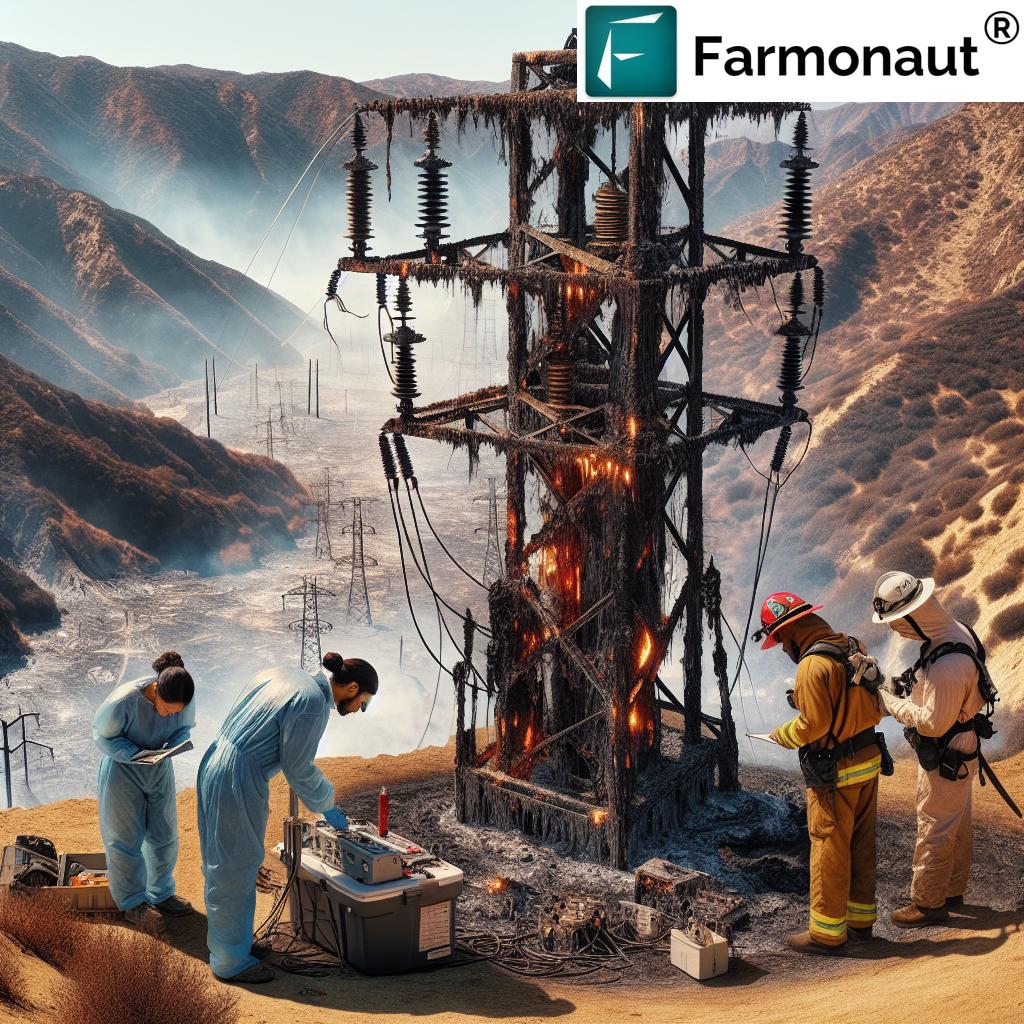Unraveling California’s Wildfire Mystery: Electrical Equipment Inspection and Fire Cause Analysis in Los Angeles County
“California wildfire investigation scrutinizes 3 transmission towers in Eaton Canyon, where residents captured video evidence.”
As we delve into the complex investigation surrounding the recent devastating wildfire in Los Angeles County, California, we find ourselves at the intersection of technology, public safety, and environmental concerns. The California wildfire investigation has intensified, with experts meticulously examining electrical equipment in the aftermath of this disastrous fire. In this comprehensive analysis, we’ll explore the ongoing efforts to determine the cause of the fire, the implications for the utility industry, and the broader impact on wildfire prevention strategies.
The Unfolding Investigation
The focus of the investigation has centered around three transmission towers in Eaton Canyon, where residents captured crucial video evidence of flames near transmission lines. This visual documentation has placed Southern California Edison under intense scrutiny from day one of the investigation. As we unravel this mystery, it’s becoming clear that the electrical equipment inspection process is both complex and critical to understanding the fire’s origin.

Southern California Edison crews have been observed scaling tall electrical towers, conducting soil resistivity testing, and capturing close-up images of electrical equipment. This thorough examination is part of a detailed effort to pinpoint exactly what sparked the Eaton fire on January 7. The investigation is likely to continue for several months before a final determination is reached.
Key Components of the Investigation
To better understand the complexity of this investigation, let’s break down its key components:
| Investigation Component | Description | Significance |
|---|---|---|
| Transmission Tower Inspections | Detailed examination of three towers in Eaton Canyon, including scaling and close-up imaging | Critical for identifying potential electrical abnormalities or damage |
| Soil Resistivity Testing | Analysis of how soil around towers absorbs and reacts to electric current | Helps understand potential grounding issues or electrical discharge into the soil |
| Image and Video Analysis | Examination of thousands of images and videos of the electrical equipment | Provides visual evidence of equipment condition before, during, and after the fire |
| Idle Tower Re-energization | Investigation of Tower M16T1, which was reportedly re-energized on the day of the fire | Could be a crucial factor in determining the fire’s ignition point |
| Lawsuit Claims | Analysis of claims made in multiple lawsuits filed against Edison | Highlights potential liability issues and areas of concern for further investigation |
The Mystery of Tower M16T1
One of the most intriguing aspects of this investigation centers around transmission tower M16T1. This tower, which had reportedly been idle for over 50 years, was somehow re-energized on the day the fire began. This unexpected reactivation has become a focal point for investigators and plaintiffs alike.
Lawsuits filed against Edison have highlighted potential electrical abnormalities associated with this tower. Plaintiffs claim that blackened marks and other signs of damage on the steel structure suggest that arcing occurred, potentially sending electricity through equipment that was supposed to have been unused for decades.
As we continue to unravel this mystery, it’s crucial to consider the implications of such an occurrence. The re-energization of long-dormant electrical equipment raises serious questions about maintenance protocols, safety measures, and the potential for unforeseen risks in our aging electrical infrastructure.
The Role of Advanced Technology in the Investigation
In the quest to determine the cause of the Eaton fire, investigators are leveraging cutting-edge technology to gather and analyze data. This approach mirrors the advancements we’re seeing in other areas of environmental monitoring and management.
For instance, carbon footprinting technologies are increasingly being used to track and reduce environmental impacts across various industries. While not directly related to wildfire investigation, these tools demonstrate the growing importance of data-driven approaches in addressing environmental challenges.
Similarly, the use of drones equipped with high-resolution cameras for tower inspections showcases how modern technology is revolutionizing traditional investigation methods. This parallels advancements in agricultural technology, where satellite imagery and AI are being used for crop monitoring and management.
Legal Implications and Mounting Lawsuits
The Eaton fire investigation has significant legal ramifications, with dozens of lawsuits filed on behalf of hundreds of residents. Los Angeles County, Pasadena, and Sierra Madre have also taken legal action against the utility giant. This litigation could potentially result in billions of dollars in damages and liability.
“Experts are analyzing thousands of images and videos to determine the origin of the devastating Los Angeles County fire.”
The legal landscape surrounding this case highlights the complex intersection of public safety, corporate responsibility, and environmental stewardship. As we navigate these challenges, it’s crucial to consider how technological advancements can help prevent such disasters in the future.

The Importance of Transparent Investigations
Southern California Edison has emphasized its commitment to a thorough and transparent investigation. This approach is crucial not only for addressing the immediate concerns surrounding the Eaton fire but also for building public trust and informing future safety measures.
Transparency in such investigations can lead to valuable insights that benefit the entire utility industry. By openly sharing findings and collaborating with experts, we can work towards more robust safety protocols and improved risk management strategies.
The Role of Data Analysis in Fire Cause Determination
A critical aspect of this investigation is the extensive data analysis being conducted. Experts are poring over thousands of images and videos, along with other relevant data points, to piece together the events leading up to the fire.
This data-driven approach to fire cause analysis is reminiscent of how advanced technologies are being applied in other fields. For example, in agriculture, satellite-based monitoring systems are being used to track crop health and predict potential issues before they escalate.
While the contexts differ, both scenarios underscore the growing importance of data analysis in understanding and mitigating environmental risks.
Soil Resistivity Testing: A Key Component of the Investigation
One of the more technical aspects of the ongoing investigation is soil resistivity testing. This process involves examining how the soil around the transmission towers absorbs and reacts to the flow of electric current. Understanding soil resistivity is crucial for several reasons:
- It helps determine the effectiveness of grounding systems
- It can indicate potential areas of electrical discharge into the surrounding environment
- It provides insights into how electrical equipment interacts with its immediate surroundings
This level of detailed analysis demonstrates the complexity of modern wildfire investigations and the multifaceted approach required to determine the cause of such incidents.
The Broader Implications for Wildfire Prevention
As we delve deeper into the Eaton fire investigation, it’s important to consider the broader implications for wildfire prevention strategies. The insights gained from this investigation could inform future policies and practices aimed at reducing the risk of wildfires caused by electrical equipment.
Some potential areas of focus might include:
- Enhanced monitoring systems for electrical infrastructure
- Improved maintenance protocols for idle or rarely used equipment
- Advanced predictive modeling to identify high-risk areas or conditions
- Integration of real-time weather data with electrical grid management systems
These approaches align with the growing trend towards data-driven decision-making in environmental management. For instance, fleet management systems in agriculture are now using real-time data to optimize operations and reduce environmental impacts. Similar principles could be applied to utility management to enhance safety and efficiency.
The Role of Public Agencies in the Investigation
The California Department of Forestry and Fire Protection and the Los Angeles County Fire Department are leading the investigation into the cause of the Eaton fire. These public agencies play a crucial role in ensuring a thorough and impartial examination of the evidence.
Their involvement underscores the importance of collaboration between public and private entities in addressing complex environmental challenges. This collaborative approach is increasingly common across various sectors, including agriculture, where partnerships between government agencies, technology providers, and farmers are driving innovation in sustainable practices.
The Impact on Utility Companies and Regulatory Frameworks
The outcome of this investigation could have far-reaching implications for utility companies and the regulatory frameworks that govern them. Depending on the findings, we might see:
- Stricter regulations on electrical equipment maintenance and inspection
- Increased investment in modernizing electrical infrastructure
- Enhanced requirements for wildfire prevention measures in high-risk areas
- Greater emphasis on transparency and public reporting of potential risks
These potential changes highlight the dynamic nature of environmental regulations and the need for industries to adapt to evolving standards. This adaptability is crucial not only in the utility sector but across all industries that interact with the environment.
The Role of Technology in Future Wildfire Prevention
As we look to the future of wildfire prevention, it’s clear that technology will play an increasingly important role. Advanced monitoring systems, predictive analytics, and real-time data processing could all contribute to more effective wildfire prevention strategies.
For example, satellite-based monitoring systems, similar to those used in crop insurance and loan verification, could be adapted to monitor electrical infrastructure in high-risk areas. These systems could provide early warnings of potential issues, allowing for proactive maintenance and risk mitigation.
The Importance of Community Engagement and Education
As the investigation continues, it’s crucial to recognize the role of community engagement and education in wildfire prevention. Residents in high-risk areas can play a vital role in early detection and reporting of potential issues.
Community education programs could focus on:
- Recognizing signs of potential electrical equipment malfunction
- Understanding the importance of maintaining clear zones around electrical infrastructure
- Knowing how to report concerns or unusual observations to relevant authorities
- Implementing personal wildfire prevention measures on private property
This community-centric approach aligns with broader trends in environmental management, where local knowledge and participation are increasingly valued in addressing complex challenges.
The Economic Impact of Wildfires and Prevention Measures
The economic implications of wildfires and the associated prevention measures are significant. From the direct costs of firefighting and property damage to the indirect costs of business disruption and environmental restoration, wildfires can have far-reaching economic impacts.
Investing in prevention measures, while potentially costly in the short term, can yield significant long-term benefits. This cost-benefit analysis is crucial for policymakers and utility companies as they consider future strategies for wildfire prevention.
Conclusion: Lessons for the Future
As we await the final determination of what caused the Eaton fire, it’s clear that this investigation will yield valuable insights for future wildfire prevention efforts. The meticulous examination of electrical equipment, the analysis of environmental factors, and the scrutiny of maintenance practices all contribute to a more comprehensive understanding of wildfire risks.
The lessons learned from this investigation will likely inform policy decisions, industry practices, and community preparedness strategies for years to come. As we face the ongoing challenges of climate change and increasing wildfire risks, the importance of thorough investigations, advanced technology, and collaborative approaches cannot be overstated.
By embracing innovation, fostering transparency, and prioritizing public safety, we can work towards a future where the devastating impacts of wildfires are significantly reduced. The Eaton fire investigation serves as a crucial step in this ongoing journey towards better environmental stewardship and public safety.
FAQs
- What is the main focus of the California wildfire investigation?
The investigation primarily focuses on three transmission towers in Eaton Canyon, where residents captured video of flames near transmission lines. - How long is the investigation expected to take?
It’s likely to take several months before a final determination of the fire’s cause is reached. - What role does soil resistivity testing play in the investigation?
Soil resistivity testing helps understand how the soil around towers absorbs and reacts to electric current, which can provide insights into potential electrical discharge issues. - Why is Tower M16T1 of particular interest in the investigation?
Tower M16T1, which had been idle for over 50 years, was reportedly re-energized on the day of the fire, making it a focal point of the investigation. - How are advanced technologies being used in the investigation?
Advanced technologies such as drones with high-resolution cameras and data analysis of thousands of images and videos are being employed to gather and analyze evidence.
For more information on innovative technologies in environmental monitoring and management, visit Farmonaut.
Earn With Farmonaut: Affiliate Program
Earn 20% recurring commission with Farmonaut’s affiliate program by sharing your promo code and helping farmers save 10%. Onboard 10 Elite farmers monthly to earn a minimum of $148,000 annually—start now and grow your income!







